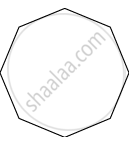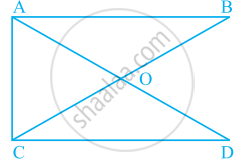Advertisements
Advertisements
प्रश्न
In a quadrilateral ABCD, AO and BO are bisectors of angle A and angle B respectively. Show that:
∠AOB = (∠C + ∠D)
उत्तर
In a quadrilateral ABCD, AO and BO are the bisectors of ∠A and ∠B, respectively. We need to prove that:
∠AOB = ∠C + ∠D.
The sum of the interior angles of a quadrilateral is: ∠A + ∠B + ∠C + ∠D = 360∘.
Since AO and BO are the bisectors of ∠A\ and ∠B\, we can express: `angleAOB=(angleA)/2+(angleB)/2`
From the sum of the interior angles of the quadrilateral, rearrange to find ∠A+∠B
∠A + ∠B = 360∘ − (∠C + ∠D).
Now substitute ∠A+∠B into the expression for ∠AOB:
`angleAOB= (angleA)/2+(angleB)/2=(angleA+angleB)/2`
Replace ∠A + ∠B with 360∘ − (∠C + ∠D)
`angleAOB=(360°-(angleC+angleD))/2`
Simplify: `angleAOB = 180°-(angleC+angleD)/2`
∠AOB = ∠C + ∠D.
APPEARS IN
संबंधित प्रश्न
In a quadrilateral, define of the following Adjacent angles .
Determine the number of sides of a polygon whose exterior and interior angles are in the ratio 1 : 5.
If ABCD is a rectangle with ∠BAC = 32°, find the measure of ∠DBC.
Observe the figure below and find out their name.

Find the angles of a quadrilateral whose angles are in the ratio 1: 4: 5: 2.
Which of the following is not true for a parallelogram?
In quadrilateral HOPE, the pairs of opposite sides are ______.
A quadrilateral can be drawn when all the four angles and one side is given.
If the sum of two angles is greater than 180°, then which of the following is not possible for the two angles?
The number of straight angles in figure is ______.
